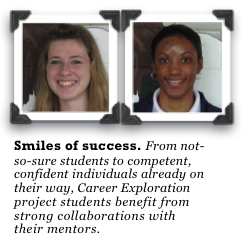by Victor Rivero
AFTER 28 YEARS OF TEACHING, CATHEY CAREY has never had it so fun. But when students are obtaining remarkable, tangible improvements in their lives, that’s to be expected.
 In her Career Exploration class at Airline High School in Bossier Parish Schools, Bossier City, Louisiana, Cathey is creating a safe space within which her students can discover for themselves what their future paths might be. With help from the International Telementor Program, the experience has taken her students from average, well-intentioned teens with vague hopes about their future—to confident, competent individuals on their way to achieving their dreams on a very practical level.
In her Career Exploration class at Airline High School in Bossier Parish Schools, Bossier City, Louisiana, Cathey is creating a safe space within which her students can discover for themselves what their future paths might be. With help from the International Telementor Program, the experience has taken her students from average, well-intentioned teens with vague hopes about their future—to confident, competent individuals on their way to achieving their dreams on a very practical level.
Explosive Results
For 90 minutes a day, five days a week, Cathey Carey’s students came together for a class like no other; on any given day, they may have been completing part of a project, sharing what progress they made with each of their mentors, or asking for feedback, constructive criticism or receiving praise for a job well done. Given recommendations, students would go back to their work, make adjustments and send what they’d done back to their mentor.  “They’d collaborate as they built their portfolio. I wasn’t lecturing, and they were doing. It was very successful,” says Cathey. Granted, the teacher’s role is vital but, says Cathey, “There is just something about working with a professional adult besides me. I’m like mama. They like what I have to say and I have positive input, but they like—and it’s more powerful coming from—the outside adult.”
“They’d collaborate as they built their portfolio. I wasn’t lecturing, and they were doing. It was very successful,” says Cathey. Granted, the teacher’s role is vital but, says Cathey, “There is just something about working with a professional adult besides me. I’m like mama. They like what I have to say and I have positive input, but they like—and it’s more powerful coming from—the outside adult.”
Before the project commenced, one particular student, Michelle, was very certain of everything. “She knew she was going to be a lawyer, what college she wanted—she knew everything,” says Cathey.
Great to be certain, but this veteran teacher had seen it before: a student who selects and then holds onto an idea,  fixing on it and merely repeating it when asked what they want to do or be in the future—but never really delving into it to any degree so as to understand what it’s truly all about.
fixing on it and merely repeating it when asked what they want to do or be in the future—but never really delving into it to any degree so as to understand what it’s truly all about.
Consequently, as the project got underway, the changes were immediate. Cathey explains:
“We got to doing our research and it was then that she made a discovery. She didn’t want to be a lawyer. In fact, she felt she was more suited for criminal justice and wants to be a criminal investigator.”
Like a powder trail to a keg, Michelle had struck upon her true purpose and simply ignited a straight line to her dreams—with explosive results. Her production, and subsequently her morale, shot way up.
“She’s become very excited, made contacts with the local law agencies here, will do interviews to gather further information, she’s completing projects and made contacts with the people at the community college,” says Cathey. “She is getting everything lined up and geared to go toward that direction (of criminal investigator). She’s even volunteered from our class and is visiting the sheriff’s station, working at the front desk on a volunteer basis.” 
The research, and communicating with her mentor, Rachel McClary—made the difference.
“Michelle likes to solve things, to find the answer, and to help people,” says Cathey. “Rather than sitting at a desk doing research and then defending and representing people, she really wanted to get out there and do something more hands-on. She had never considered that before. Some of these students have told themselves, ‘This is what I’m going to do’—but haven’t put a plan of action in motion. They’re just saying it. She actually has a plan.”

In communicating with her mentor, Michelle tapped into a connection her mentor had—her husband’s best friend was a criminal investigator. With her mentor’s help, Michelle created interview questions for the criminal investigator in her area. Her mentor also knew someone who was a dispatcher, and Michelle got some feedback from that person as well.
“This just gives her more insight from not just a textbook, but from people doing what she wants to do,” says Cathey.
Dressing the Part
The experience that is Cathey Carey’s class involves meeting once a week at the local community college. For the project Michelle and the other students were involved in, a guest speaker paid a visit.

The director of Dress for Success, a nonprofit organization contacted through Volunteers of America, advised Cathey’s student
s on “how to dress for an interview, how not to dress, what says you’re confident, what the different colors, prints, types of shoes, makeup is; how you present yourself and what impression you are making, and what’s appropriate,” says Cathey. An invitation was extended to visit the Dress for Success boutique, where the students received not only a free fitting, but free interview suits as well.
“They actually got two each,” raves Cathey. “It was so much fun and made my students feel so special. They got shoes, a handbag, all that type of stuff so that they were each dressed successfully.” When they presented their completed projects to the group at the community college, “They looked beautiful, professional and competent,” says Cathey.
 Before, “They weren’t really focused. You’re going to feel confident when you know what you’re wanting to do and where you’re going,” Cathey says. “The clothes just helped give them an air of confidence. They looked so poised and professional standing there speaking. They were no longer nervous high school students. I was very proud of them. You should have seen how they held themselves. They knew they looked confident.”
Before, “They weren’t really focused. You’re going to feel confident when you know what you’re wanting to do and where you’re going,” Cathey says. “The clothes just helped give them an air of confidence. They looked so poised and professional standing there speaking. They were no longer nervous high school students. I was very proud of them. You should have seen how they held themselves. They knew they looked confident.”
The students sent photos to their mentors and got feedback. With their mentor’s help, the students collected information for a portfolio and powerpoint poster, collaborating as they went. Michelle’s mentor was certain that she would do a good job and that she would make a good impression in any interview.
All in All
“It was another successful project,” Cathey says. “I definitely want to do this again with some other students. It has been very successful.  I love the telementor project. I enjoyed seeing and was very proud of how the students had their plans.” When Cathey’s class met at the community college, another teacher, Kathy Doyle, was also doing the same project with her class. “That was interesting, too, because we could share what each student was doing, what the mentors were telling them and what they were learning about the career they were researching.”
I love the telementor project. I enjoyed seeing and was very proud of how the students had their plans.” When Cathey’s class met at the community college, another teacher, Kathy Doyle, was also doing the same project with her class. “That was interesting, too, because we could share what each student was doing, what the mentors were telling them and what they were learning about the career they were researching.”
The energy and support gener
ated in that environment was unprecedented. “These two classes really bonded,” says Cathey. “They forged friendships, exchanged numbers—it was mostly females—only one male. Poor, poor guy! But they all bonded and though they were from different schools and never would have met—they became great friends and encouraged each other.”

As a high school teacher, Cathey says her entire Career Exploration class was centered around the telementor project. Everything from the research to the interaction with mentors was broken down into easily doable steps, and the mentors all had copies of the syllabus, Cathey explains. “They knew what our objectives were and what they were supposed to be working on each step of the way. Sometimes I communicated back and forth with the mentors as well.”
For those readers curious about creating the same or a similar project, Cathey had this to say: “I would recommend you look into it. It’s very hands-on. The students were very motivated. I’m not standing up lecturing, I’m walking around talking.  We’re collaborating, and I’m merely guiding the students. The class flew by. There’s no boredom. It was something they were excited about—they would rush to check their messages from their mentors—and even after it’s done, they are still excited by what they learned and how they grew.” ◼
We’re collaborating, and I’m merely guiding the students. The class flew by. There’s no boredom. It was something they were excited about—they would rush to check their messages from their mentors—and even after it’s done, they are still excited by what they learned and how they grew.” ◼


